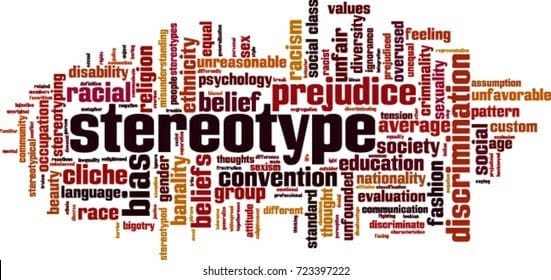STEREOTYPES – Atlantic International University
August 25, 2022 2023-09-18 21:21STEREOTYPES – Atlantic International University
“A woman’s place is in the kitchen”. This is one gender stereotype that is still prevalent in most parts of Africa, and it has been used to justify various forms of stigmatization and injustice against the feminine gender, but thanks to civilization, women have proven time and again that everyone can be what they want to be, that there is greatness in everyone, regardless of gender, and that being a woman does not mean being less capable of achieving greatness.
That phrase about women is just one example of a stereotype; there are many others, ranging from individuals to nationalities. ‘Americans are loud,’ for example, is an example of a National Stereotype.
“Social psychology defines a stereotype as a generalized belief about a particular category of people. It is an expectation that people might have about every person of a particular group. The type of expectation can vary; it can be, for example, an expectation about the group’s personality, preferences, appearance or ability. Stereotypes are sometimes overgeneralized, inaccurate, and resistant to new information, but can sometimes be accurate. While such generalizations about groups of people may be useful when making quick decisions, they may be erroneous when applied to particular individuals and are among the reasons for prejudicial attitudes.”– Wikipedia.
Regardless of how hard we try Stereotypes are usually difficult to ignore, especially if they are false, because they are widely accepted, lowering the victim’s self-esteem over time, especially if they are related to one’s ability.
When a stereotype persists for a long period of time, the victims eventually accept the saying, begin to have self-doubts, and tend to do anything to comply in order not to act against the negative perception. Psychologists call this stage a “stereotype threat.”
“Stereotype threat is a situational predicament in which people are or feel themselves to be at risk of conforming to stereotypes about their social group. It is theorized to be a contributing factor to long-standing racial and gender gaps in academic performance.” – Wikipedia
There are various types of stereotypes, which include:
Cultural Stereotype – Each culture has distinguishing characteristics that set it apart from other cultures. This uniqueness is likely to be subjected to positive or negative stereotypes, which are typically directed at either the individual from such cultural background or the entire culture as a whole. The phrase “Jamaicans like to smoke pot” is an example of a cultural stereotype.
Social Stereotype – This is a type of stereotype that is directed at people’s socioeconomic status, skill, age, and so on. One such example is the adage “Smart Girls Aren’t Pretty.”
Racial Stereotype – This type of stereotype usually results in racial discrimination against a group of people by focusing on their race, color, ethnicity, and so on. One example is the proverbial ‘black athletes in the NBA are thugs.’
Gender Stereotype – This is typically a comparison and contrast of different genders. “A woman’s place is in the kitchen,” for example, is a stereotype.
Religious Stereotype – This is a serious form of a stereotype because it is directed at a person’s faith and belief. If it is negative, it will have serious consequences.
If stereotyping is an evil act, we are all guilty at some point; we all stereotype, some good and some bad, and we generalize on numerous occasions. To deal with stereotyping, you might want to consider the following:
- Stop assuming and passing judgment on people from afar. At times, we have a tendency to judge what we do not know or understand. If you notice that someone looks different, the best way to find out why is to ask. So get close and investigate for yourself; what you are witnessing may simply be a reflection of the person’s current state, and you may eventually be of assistance.
- Everyone has a good side and a bad side; look for people’s good side. We sometimes see only what we want to see; it pays to see the positive aspects, so concentrate on them.
- Look inwards; there is always a reason for doing something, so always ask yourself why you do what you do.
- We may not always see the problem from the same perspective, but it is useful to put yourself in the shoes of the other person before passing judgment.
- When asking clarifying questions, make sure to call a spade a spade. Be genuine while remaining open without generalizing.
- We stereotype when we don’t understand what stereotyping does to the person or people to whom the act is directed. More specifically, when the purpose of something is unknown, abuse is unavoidable, so educate yourself, read about other people’s cultures and traditions, and learn why a certain trait is prevalent in one tribe.
- Devote more of your energy to something that will benefit both you and the world. Change your attention to something else.
- If you are the one who has been stigmatized, get help, seek advice, and refuse to doubt yourself.
Because there are more negative stereotypes than positive stereotypes, stereotyping has done more harm than good to individuals and groups of people. Every individual is unique, regardless of tribe; a tribe should not be painted with the same brush simply because a few individuals acted in a certain way.
“If you want to uplift and change your community.
f you want to uplift and change your hood, projects , ghetto or township.
Change the stereotype believes.
Our society is held back, not to progress or develop, because of the type of stereotypes we have within our community. If we break those stereotypes. We would find our freedom, happiness, progress and success.” ? De philosopher DJ Kyos
Sources
https://examples.yourdictionary.com/stereotype-examples.html
https://www.militaryspouse.com/spouse-101/stereotyping/10-ways-to-stop-the-stereotyping/
























